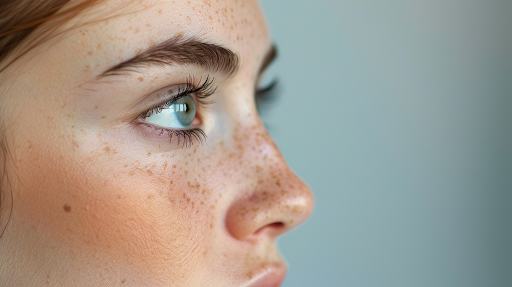Bulbous Nose Rhinoplasty | (Rhinophyma) Surgeons
What is a bulbous nose?
The nose is one of the most prominent and recognizable parts of our face, so it’s not surprising that many people scrutinize its appearance and consider surgical procedures for any perceived imperfections. Noses come in all shapes and sizes, and while some may say that a distinctive nose “gives character,” many of us find ourselves critically examining our features, especially our noses, every day in the mirror.
Even if the bridge and upper part of your nose are slim and small, it’s possible to have a larger, uniquely shaped tip that seems disproportionate to the rest of your face. Some people have round, wide, and swollen-looking nasal tips with little to no contour or definition. These are known as bulbous nasal tips, which can be corrected with bulbous nose surgery.
When patients with bulbous nasal tips visit Dr. Mourad, they often express concerns about the width, roundness, and overall size of their noses. This is understandable, as well-contoured and proportionate noses are often considered attractive in today’s society. A bulbous tip can appear mismatched with the rest of the nose in terms of shape or size, and it may also look upturned or droopy.
Consult a facial plastic and reconstructive surgeon
What causes a bulbous nose?
A bulbous appearance is typically caused by one of the following factors, including:
- Weak cartilage: Insufficiently strong cartilage can lead to a bulbous nose.
- Abnormal alar cartilage: Irregular anatomy of the alar cartilage can result in a bulbous nose.
- Thick skin: Excessively thick skin at the tip of the nose can create a bulbous shape.
- Hypertrophic lower lateral cartilage: Enlarged lower lateral cartilage beneath the skin can also cause a bulbous nose.
If you’re curious about the cause of your bulbous nose, you can schedule an appointment with Dr. Mourad, a Double Board-Certified Plastic Surgeon, for an assessment and professional opinion. Understanding the cause of your nose shape will help determine the most suitable nose tip surgery technique for correction.
How can you fix a bulbous nose?
Correcting bulbous tips with a bulbous nose job is a standard procedure. This surgery reshapes the nose, giving it a softer yet more defined appearance. Dr. Mourad can refine and reshape the cartilage and soft tissue to adjust the tip’s shape. While every nose is unique, the most sought-after tip shape is often sharp and slope-like. Using his expertise, Dr. Mourad employs surgical techniques to achieve a natural and proportionate look.
There are two main types of rhinoplasty: open rhinoplasty and closed rhinoplasty. Both methods are effective treatments, depending on the specific structural issues and nasal bridge considerations. Dr. Mourad will create a customized treatment plan to address your unique needs and ensure the best possible outcome.
Open Rhinoplasty
This invasive procedure involves a small incision on the undersurface of the nose, allowing the surgeon to expose all internal structures, including the nasal tip, bridge, and bones. It is the most extensive type of surgery, enabling significant alterations. This surgical treatment is ideal for patients with considerable issues such as crooked, enlarged, misshapen, or disfigured noses. It also benefits those with extensive breathing issues. Open rhinoplasty is particularly effective for patients with poor cartilage strength, excess tissue, or challenging nasal skin. It is also suitable for individuals who have had previous rhinoplasty procedures and require further correction.
Closed Rhinoplasty
This less invasive procedure hides the incisions inside the nostrils. It allows for smaller modifications to the nasal tip, addressing its projection, rotation, and shape. This type of surgery is suited for patients with minor breathing complaints or aesthetic concerns focused on the nasal tip. It targets the nasal cartilage and septum while preserving the nasal skin and bones’ integrity.
Dr. Mourad can address the bulbous tip during a full rhinoplasty to improve the overall size and shape of the nose or through a smaller rhinoplasty specifically targeting the tip. However, focusing solely on the tip can sometimes lead to structural weaknesses over time. If the wider shape of your nose is due to thicker nasal tip skin, Dr. Mourad can thin out the nasal tip to achieve the desired results.
With a thorough understanding of your medical history and specific anatomical structure, Dr. Mourad will recommend the most suitable cosmetic procedures and surgical treatments to meet your aesthetic and functional goals.
The Best Rhinoplasty Surgeon in NYC
What is recovery after a bulbous tip rhinoplasty?
Downtime following bulbous nose surgery is about two weeks. During this period, you should rest with your head elevated as often as possible. Ensure you have plenty of pillows ready for your recovery before surgery day. On the day of the plastic surgery procedure, you will leave Dr. Mourad’s office with a cast, taping, and stitches. The taping can be removed 2-3 days after surgery. Dr. Mourad will provide specific instructions on cleaning and maintaining the area until the cast and stitches are removed, typically a little over a week later.
Don’t be alarmed if you notice swelling after your rhinoplasty. Swelling is normal and will gradually decrease over several months. You won’t see the final results until a full year after surgery, but rest assured that 90% of the swelling subsides within the first three months. Since bulbous nose surgery primarily targets the nasal tip, the most sensitive part of the nose, it may take the longest to heal compared to other areas.
After your bulbous nose surgery, avoid driving for five to seven days, non-contact sports for three weeks, and contact sports for six weeks. Rhinoplasty surgery is not something you can bounce back from immediately, so avoid strenuous activities like weight lifting and cardio. Be patient, allowing yourself time to rest and heal properly to avoid the need for revision surgery. The result will be worth it when you see your dream nose with its slim, pointed tip shine through.
Dr. Mourad can address the entire nose, including the nasal bones, lateral cartilages, and nasal septum, to enhance nasal function and aesthetics. He will consider various treatment options based on your specific risk factors, skin conditions, and the layers of skin involved. By carefully managing blood vessels and excess tissue, Dr. Mourad ensures a balanced and natural outcome from this cosmetic procedure.
Is Nose Tapping Necessary After Rhinoplasty?
When will I see results?
After undergoing bulbous tip nose surgery, you may begin to see results by weeks 2 to 3. However, it takes several months for swelling and bruising to fully heal. Some residual swelling may persist for up to a year, meaning the final result of your rhinoplasty may not be visible until a year after the procedure. Each patient is unique, so your swelling may subside within a few months, allowing you to see the final result of your rhinoplasty sooner than a year.
The results of bulbous tip nose surgery are permanent. Once your rhinoplasty is complete, no follow-up procedures are necessary. During the first year, the tip of your nose may change in appearance as it heals from swelling and bruising. By the one-year mark, you can feel confident that the tip you see is the permanent result of your surgery.
Bulbous tip nose surgery, often part of the treatment of rhinophyma, is an effective procedure performed by a facial plastic surgeon. This surgical approach involves precise suture techniques to reshape the nose. While the recovery time can involve several months of reduced swelling, it’s important to avoid strenuous activities during this period and gradually resume normal activities.
Patients may sometimes experience nasal obstruction or other potential risks, but these are typically managed without the need for additional procedures. Trusting in the expertise of your surgeon and adhering to post-operative care instructions will ensure the best possible outcome from this cosmetic surgery.
What is the cost of a bulbous tip rhinoplasty?
The cost of bulbous tip rhinoplasty varies depending on the complexity of the procedure. For a more accurate estimate tailored to your needs, schedule a consultation with your plastic surgeon.
During the consultation, your surgeon will conduct a physical exam and discuss both surgical solutions and non-surgical nose jobs using dermal fillers. With extensive experience and feedback from previous patients, your surgeon can provide realistic expectations and help determine the best approach for your rhinoplasty. Remember, while non-surgical options may offer temporary improvements, a bulbous tip rhinoplasty provides a permanent solution.
Expert Spotlight: Dr. Moustafa Mourad
Dr. Moustafa Mourad, MD, FACS, is a preeminent facial plastic and reconstructive surgeon based in New York City. With dual board certifications in Facial Plastic & Reconstructive Surgery and Head & Neck Surgery, Dr. Mourad’s expertise is widely recognized. He holds fellowships with the American College of Surgeons and memberships with the American Academy of Facial Plastic and Reconstructive Surgery.
Dr. Mourad is particularly distinguished for his contributions to revision rhinoplasty, where he leverages his extensive knowledge and surgical skills to correct and enhance previous surgical outcomes. He currently serves as the Fellowship Co-Director for the American Academy of Facial Plastic & Reconstructive Surgery, training elite candidates in the nuanced art of rhinoplasty and other facial surgeries. His role as Chief of Otolaryngology-Head & Neck Surgery at Medisys Health Systems further underscores his commitment to advancing surgical practices and patient care in the New York City area.













